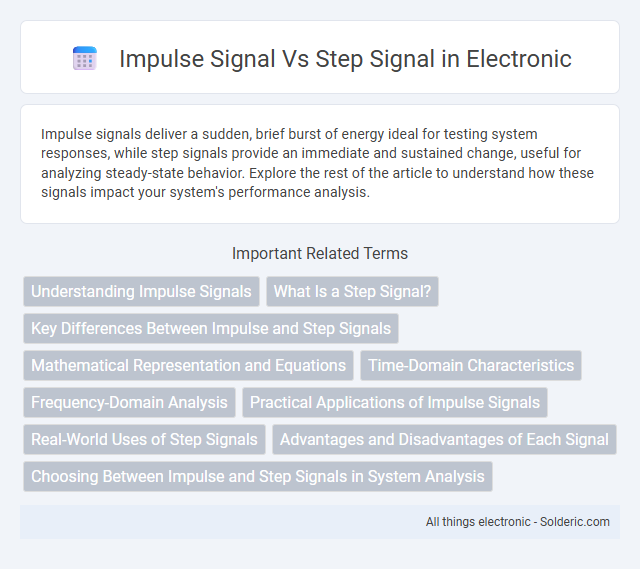Impulse signals deliver a sudden, brief burst of energy ideal for testing system responses, while step signals provide an immediate and sustained change, useful for analyzing steady-state behavior. Explore the rest of the article to understand how these signals impact your system's performance analysis.
Comparison Table
| Aspect | Impulse Signal | Step Signal |
|---|---|---|
| Definition | A signal with all energy concentrated at a single instant (Dirac delta) | A signal that changes from zero to a constant value abruptly and remains constant |
| Mathematical Representation | d(t) (Dirac delta function) | u(t) (Heaviside step function) |
| Energy | Finite energy concentrated at t=0 | Infinite duration, constant amplitude after t=0 |
| Use in System Analysis | Impulse response characterizes system behavior completely | Step response indicates cumulative system behavior over time |
| Frequency Domain | All frequencies equally present (broadband) | Contains low-frequency components predominant |
| Physical Realization | Approximated by very short pulses | Implemented by sudden switching or constant inputs |
Understanding Impulse Signals
Impulse signals, often represented mathematically by the Dirac delta function, serve as idealized inputs in system analysis due to their infinitely short duration and unit area, enabling the characterization of system responses. Unlike step signals, which represent sudden changes sustained over time, impulse signals provide valuable insights into system dynamics by revealing the intrinsic behavior through the system's impulse response. This fundamental concept underpins techniques such as convolution and Fourier analysis, essential for signal processing and control systems engineering.
What Is a Step Signal?
A step signal is a type of discontinuous input that instantaneously changes from one constant value to another, often from zero to a specific amplitude, and remains at that level indefinitely. It is commonly used in control systems and signal processing to analyze system response over time, especially for studying stability and transient behavior. Understanding your system's reaction to a step signal helps determine its time-domain characteristics such as rise time, settling time, and steady-state error.
Key Differences Between Impulse and Step Signals
Impulse signals are characterized by a sudden, brief spike at a single point in time, often idealized as having zero duration and unit area, whereas step signals represent a sudden change from zero to a constant value that persists indefinitely. Impulse signals are used to analyze system responses in terms of instantaneous effects, while step signals examine steady-state behavior and transient response over time. Your understanding of these signals helps in system identification and control design by highlighting how systems react to instantaneous versus sustained inputs.
Mathematical Representation and Equations
An impulse signal is mathematically represented by the Dirac delta function d(t), which is zero everywhere except at t = 0, where it is infinitely large, satisfying the property _{-}^{} d(t) dt = 1. A step signal is described by the Heaviside step function u(t), defined as zero for t < 0 and one for t >= 0, commonly used to model sudden changes in systems. Your understanding of system responses can be enhanced by analyzing these functions in differential equations, where d(t) acts as the derivative of u(t), highlighting their intrinsic mathematical relationship.
Time-Domain Characteristics
Impulse signals exhibit a sharp, instantaneous spike at a single point in time, representing a sudden, brief event with zero duration and infinite amplitude in theory, making them ideal for analyzing system responses. Step signals maintain a constant amplitude after an instantaneous rise at a specific time, modeling sudden changes that sustain over time, useful for studying system stability and long-term behavior. Understanding these distinct time-domain characteristics helps you accurately interpret system dynamics and responses in signal processing and control applications.
Frequency-Domain Analysis
Impulse signals contain a broad range of frequencies, making them ideal for frequency-domain analysis to characterize system responses comprehensively. Step signals primarily emphasize low-frequency components and are used to observe a system's steady-state and transient behavior. Your frequency-domain analysis benefits from using impulse signals for full-spectrum insights, while step signals reveal cumulative system dynamics.
Practical Applications of Impulse Signals
Impulse signals are widely used in system identification and control engineering to analyze the dynamic response of electronic circuits and mechanical systems. Your ability to study transient behaviors and resonance frequencies relies on the precise application of these signals in testing and measurement. Impulse signals also play a crucial role in radar and communication systems for accurate detection and timing synchronization.
Real-World Uses of Step Signals
Step signals are widely used in control systems for testing system response and stability, particularly in engineering fields such as robotics and automation. They simulate sudden changes in input, allowing engineers to analyze transient and steady-state behavior in systems like temperature controllers and electronic circuits. Step signals also facilitate calibration and tuning of feedback loops in industrial processes and communication systems.
Advantages and Disadvantages of Each Signal
Impulse signals offer precise time localization, making them ideal for system identification and analysis of transient responses, but their high frequency content can introduce noise and practical measurement challenges. Step signals are advantageous for evaluating steady-state system behavior and stability due to their longer duration and gradual change, yet they may obscure dynamic characteristics and transient effects. Choosing between impulse and step signals depends on your specific application needs, balancing sensitivity to rapid changes against clarity in long-term response.
Choosing Between Impulse and Step Signals in System Analysis
Impulse signals provide a brief, instantaneous input that excites all frequencies of a system, making them ideal for analyzing system dynamics and obtaining the impulse response. Step signals introduce a sudden, sustained change, revealing the system's steady-state behavior and enabling the determination of time constants and settling times. Selecting between impulse and step signals depends on whether the primary goal is to capture transient responses or evaluate long-term system stability.
impulse signal vs step signal Infographic

 solderic.com
solderic.com